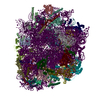+Search query
-Structure paper
| Title | Ribosome inhibition by C9ORF72-ALS/FTD-associated poly-PR and poly-GR proteins revealed by cryo-EM. |
|---|---|
| Journal, issue, pages | Nat Commun, Vol. 13, Issue 1, Page 2776, Year 2022 |
| Publish date | May 19, 2022 |
 Authors Authors | Anna B Loveland / Egor Svidritskiy / Denis Susorov / Soojin Lee / Alexander Park / Sarah Zvornicanin / Gabriel Demo / Fen-Biao Gao / Andrei A Korostelev /   |
| PubMed Abstract | Toxic dipeptide-repeat (DPR) proteins are produced from expanded GC repeats in the C9ORF72 gene, the most common genetic cause of amyotrophic lateral sclerosis (ALS) and frontotemporal dementia (FTD). ...Toxic dipeptide-repeat (DPR) proteins are produced from expanded GC repeats in the C9ORF72 gene, the most common genetic cause of amyotrophic lateral sclerosis (ALS) and frontotemporal dementia (FTD). Two DPR proteins, poly-PR and poly-GR, repress cellular translation but the molecular mechanism remains unknown. Here we show that poly-PR and poly-GR of ≥20 repeats inhibit the ribosome's peptidyl-transferase activity at nanomolar concentrations, comparable to specific translation inhibitors. High-resolution cryogenic electron microscopy (cryo-EM) reveals that poly-PR and poly-GR block the polypeptide tunnel of the ribosome, extending into the peptidyl-transferase center (PTC). Consistent with these findings, the macrolide erythromycin, which binds in the tunnel, competes with poly-PR and restores peptidyl-transferase activity. Our results demonstrate that strong and specific binding of poly-PR and poly-GR in the ribosomal tunnel blocks translation, revealing the structural basis of their toxicity in C9ORF72-ALS/FTD. |
 External links External links |  Nat Commun / Nat Commun /  PubMed:35589706 / PubMed:35589706 /  PubMed Central PubMed Central |
| Methods | EM (single particle) |
| Resolution | 2.4 - 3.1 Å |
| Structure data | EMDB-26033, PDB-7too: EMDB-26034, PDB-7top: EMDB-26035, PDB-7toq: EMDB-26036, PDB-7tor: EMDB-26037, PDB-7tos: |
| Chemicals |  ChemComp-ZN: |
| Source |
|
 Keywords Keywords | RIBOSOME / Ribosomal binding peptide / ALS/FTD-associated dipeptide repeat protein |
 Movie
Movie Controller
Controller Structure viewers
Structure viewers About Yorodumi Papers
About Yorodumi Papers















 homo sapiens (human)
homo sapiens (human)
